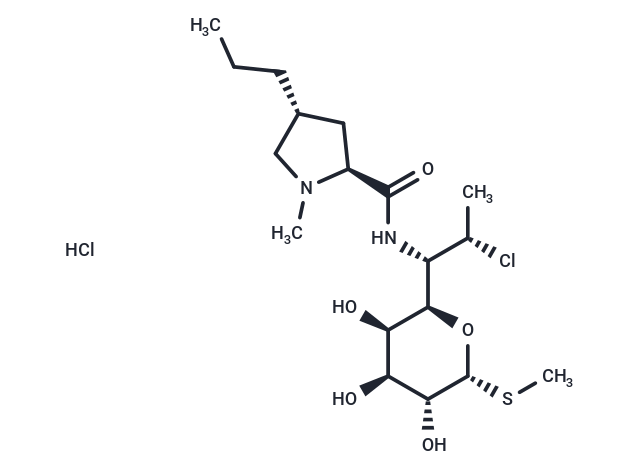Shopping Cart
- Remove All
 Your shopping cart is currently empty
Your shopping cart is currently empty

Clindamycin hydrochloride (Clinimycin HCl) inhibits protein synthesis by acting on the 50S ribosomal. It is the hydrochloride salt form of clindamycin, a semi-synthetic, chlorinated broad-spectrum antibiotic produced by chemical modification of lincomycin. Clindamycin hydrochloride(Clinimycin HCl) is used as a solid in capsules.

| Pack Size | Price | Availability | Quantity |
|---|---|---|---|
| 50 mg | $40 | In Stock | |
| 100 mg | $48 | In Stock | |
| 200 mg | $59 | In Stock | |
| 1 g | $91 | In Stock | |
| 1 mL x 10 mM (in DMSO) | $50 | In Stock |
| Description | Clindamycin hydrochloride (Clinimycin HCl) inhibits protein synthesis by acting on the 50S ribosomal. It is the hydrochloride salt form of clindamycin, a semi-synthetic, chlorinated broad-spectrum antibiotic produced by chemical modification of lincomycin. Clindamycin hydrochloride(Clinimycin HCl) is used as a solid in capsules. |
| In vitro | Clindamycin is a classical inhibitor of bacterial protein synthesis which binds to the 23S ribosomal RNA of the 50S ribosomal subunit. [1] |
| In vivo | Clindamycin hydrochloride is rapidly absorbed orally in dogs, exhibiting a mean absorption time (MAT) of 0.87 hours and a bioavailability of 72.55%. It shows a total clearance (CL) rate post intravenous (IV) and oral administration of 0.503 and 0.458 L/h/kg respectively, and reaches a steady-state volume of distribution (IV) of 2.48 L/kg, indicating extensive distribution throughout the body's fluids and tissues. Serum concentrations of clindamycin remain above 0.5 μg/mL for approximately 10 hours after both IV and oral administration. [1] Additionally, it significantly reduces oral malodor, dental plaque, dental calculus, and gingival bleeding in dogs over a period of 42 days. [2] At a dosage of 2.5 mg/lb following ultrasonic scaling, root planing, and polishing (USRP), clindamycin significantly impacts plaque and pocket depth related to periodontal disease, though not gingivitis. [3] Furthermore, it achieves a complete remission ratio of 71.4% (15/21) in dogs with canine superficial bacterial pyoderma within 14 to 28 days. [4] |
| Kinase Assay | In vitro potency assays: After RO4929097 is used, the Aβ peptides are measured by ECL assays using a variety of anti-Aβ antibodies and an Origen 1.5 Analyzer. The 4 g8 murine mAb binds an epitope in the Aβ peptide (within amino acids 18–21) that is immediately distal to the α-secretase cleavage site. The G2–10 murine mAb binds the C terminus that is exposed after γ-secretase-mediated cleavage to generate amino acid 40 of the Aβ40 peptide. The FCA3542 rabbit antibody binds the C terminus that is exposed after γ-secretase-mediated cleavage to generate amino acid 42 of the Aβ42 peptide. The 4 g8 mAb is biotinylated with biotin-LC-sulfo-N-hydroxysuccinimide-ester. The G2–10 and FCA3542 antibodies are ruthenylated with TAG-N-hydroxysuccinimide ester. Aβ(x-40) is detected with biotinylated 4 g8 and ruthenylated G2–10. Aβ(x-42) is detected with biotinylated 4 g8 and ruthenylated FCA3542. |
| Alias | Sobelin HCl, Clinimycin HCl, Clindamycin HCl, Cleocin |
| Molecular Weight | 461.44 |
| Formula | C18H33ClN2O5S·HCl |
| Cas No. | 21462-39-5 |
| Smiles | Cl.CCC[C@@H]1C[C@H](N(C)C1)C(=O)N[C@H]([C@H](C)Cl)[C@H]1O[C@H](SC)[C@H](O)[C@@H](O)[C@H]1O |
| Relative Density. | no data available |
| Storage | Powder: -20°C for 3 years | In solvent: -80°C for 1 year | Shipping with blue ice. | |||||||||||||||||||||||||||||||||||
| Solubility Information | DMSO: 75 mg/mL (162.53 mM), Sonication is recommended. | |||||||||||||||||||||||||||||||||||
Solution Preparation Table | ||||||||||||||||||||||||||||||||||||
DMSO
| ||||||||||||||||||||||||||||||||||||

Copyright © 2015-2025 TargetMol Chemicals Inc. All Rights Reserved.